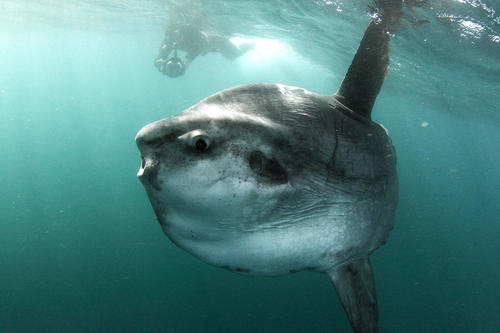
Ocean Sunfish
The Atlantic bluefin tuna (Thunnus thynnus) is a highly migratory, large pelagic fish renowned for its size, speed, and commercial value. It plays a crucial role in the marine ecosystem as a top predator. This species is known for its remarkable migrations across the Atlantic Ocean.
Unknown 10 years
Lifespan
300 - 400 cm
Length
Vulnerable
Conservation Status
3 km/h
Swimming speed
Carnivorous
Diet
Pelagic Migration
Migration
Appearance Overview
The Atlantic bluefin tuna is a large, torpedo-shaped fish with a metallic blue body and a silvery underside.
Coloration
Dark metallic blue on top, silvery underside
Body Shape
Torpedo-shaped and streamlined
Fins
Two dorsal fins, the first depressible into a groove
Finlets
Small finlets running from the second dorsal and anal fins to the tail
Length
Up to 13 feet (4 meters)
Weight
Up to 2,000 lbs (907 kg)
Diet
Carnivorous, feeding on smaller fish (like mackerel, herring, and sardines), squid, and crustaceans.
Feeding Behavior
Highly active predator that hunts by sight, often feeding near the surface but also diving to considerable depths. They use their speed and agility to capture prey.
Social Behavior
Forms large schools, especially when young. Schools can be mixed with other tuna species. They exhibit complex migratory patterns.
Commercial Relevance
Extremely high value, particularly in the sushi and sashimi markets, where premium cuts can fetch very high prices.
Conservation measures
Subject to international fishing quotas and management plans by organizations like ICCAT. Efforts include monitoring, catch limits, and anti-illegal fishing measures.
Status
Endangered
Threats
Historically severe overfishing, particularly due to demand for sushi. Bycatch in fisheries targeting other species is also a threat. Climate change may affect their prey distribution.
Habitat Distribution
Depth Range
0-1,000 meters (0-3,280 feet), though they are most commonly found in the upper layers of the ocean.
Geographic Range
Found throughout the North Atlantic Ocean, including the Mediterranean Sea.
Preferred Environment
Pelagic, open ocean environments. They prefer temperate waters but also range into subtropical and tropical zones.
Reproduction and Life Cycle
Breeding Habits
Spawns in two main areas: the Mediterranean Sea and the Gulf of Mexico. Spawning occurs in warm waters, typically from May to July.
Development Stages
Eggs hatch into larvae, which are planktonic. Juveniles grow rapidly, feeding voraciously. They transition through several life stages, gradually becoming apex predators.
Fecundity
Females are highly fecund, capable of producing up to 30 million eggs per spawning season.
Maturity Age
Reaches sexual maturity between 4-8 years of age.
Faqs about Ocean Sunfish
Where are Atlantic bluefin tuna found?
Atlantic bluefin tuna are found in the Atlantic Ocean, ranging from the cold waters of the North Atlantic to the warmer tropical waters. They are also found in the Mediterranean Sea.
How long do Atlantic bluefin tuna live?
They can live up to 40 years, though many do not reach this age due to fishing pressure.
How fast can an Atlantic bluefin tuna swim?
Atlantic bluefin tuna are among the fastest fish in the ocean, capable of reaching speeds up to 43 mph (70 km/h) in short bursts.
Is it legal to fish for Atlantic bluefin tuna?
Yes, but it is highly regulated due to their endangered status. Strict quotas and fishing seasons are in place.
What do Atlantic bluefin tuna eat?
They primarily feed on smaller fish like mackerel, herring, and sardines, as well as squid and crustaceans.
When do Atlantic bluefin tuna reach maturity?
They reach sexual maturity at around 4-8 years of age, depending on their location and environmental conditions.
How many eggs do they lay?
Females can release millions of eggs each spawning season. The exact number varies depending on the size and health of the female.
Is it ethical to eat Atlantic bluefin tuna?
While their meat is highly prized, the endangered status of Atlantic bluefin tuna makes consumption a complex issue. Sustainable alternatives are recommended.
Copyright @ Nature Style Limited. All Rights Reserved.
 English
English